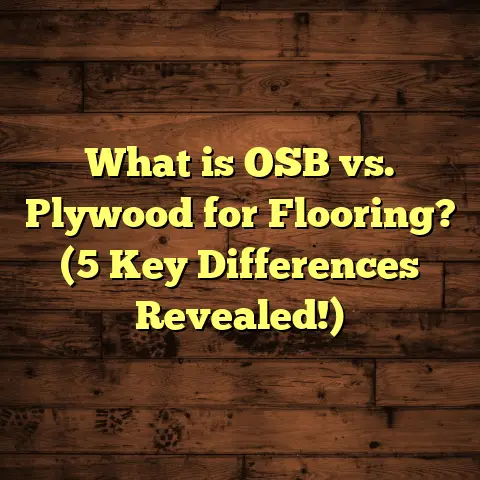What is Wall and Floor Tiling? (5 Key Benefits for Homeowners)
I still remember the day I decided to cover my kitchen floor and bathroom walls with tiles. I had just moved into my first home, and the floors were covered in worn-out linoleum while the bathroom walls showed signs of water damage. The idea of tiling felt overwhelming at first. Would it be too expensive? How long would it take? Could I trust the new tiles to last? But after months of research, planning, and finally doing the work myself (with some professional help), I realized how much tiling changed not just the look of my home but also how I felt living in it.
That experience taught me a lot about the true value of wall and floor tiling, beyond the obvious beauty. Over the years, as I gained experience both as a homeowner and flooring contractor, I’ve seen how tiling can protect your home, enhance comfort, and even boost its value. In this article, I want to share everything I’ve learned — what wall and floor tiling really is, why it’s such a smart choice for homeowners, and how you can make it work best in your own home.
What is Wall and Floor Tiling?
At its core, wall and floor tiling is the process of covering surfaces with tiles made from various materials such as ceramic, porcelain, natural stone (like granite or marble), glass, or vinyl. This process involves several steps: preparing the surface (which may include leveling or waterproofing), applying an adhesive or mortar, carefully placing the tiles in a pattern or layout, and then sealing the gaps between tiles with grout.
Wall tiling typically happens in areas exposed to moisture or where aesthetics are important—think bathrooms, kitchens, laundry rooms, or even decorative accent walls in living spaces. Walls often use smaller tiles or mosaics for visual interest.
Floor tiling, on the other hand, involves covering horizontal walking surfaces both inside and outside the home. These tiles need to be especially durable because they endure constant foot traffic, furniture movement, and sometimes outdoor weather conditions.
Materials Used in Wall and Floor Tiling
Let me break down some common tile materials I’ve worked with over the years:
- Ceramic Tiles: Made from clay fired at high temperatures; they’re affordable ($3-$10 per sq ft for materials) and come in countless designs. Ideal for walls and low-traffic floors.
- Porcelain Tiles: A subtype of ceramic but denser and less porous. They resist water well and are great for both floors and walls. Cost ranges from $5-$15 per sq ft.
- Natural Stone Tiles: Includes marble, granite, slate, travertine. These are pricier ($10-$30 per sq ft), require sealing but offer unmatched natural beauty and durability.
- Glass Tiles: Mostly used on walls for decorative backsplashes or accents; prices range $15-$30 per sq ft.
- Vinyl Tiles: A flexible alternative with easy installation but less durable; cost-effective at $2-$7 per sq ft.
Installation Process Overview
From my experience, tile installation usually follows these steps:
- Surface Preparation: This can take days depending on the existing surface condition. Floors may require leveling compound; walls may need waterproof membranes.
- Layout Planning: Measuring accurately is critical as mistakes become costly once tiles are cut or laid.
- Adhesive Application: Using thin-set mortar or mastic; porcelain usually needs thin-set.
- Tile Placement: Tiles are set carefully with spacers to ensure even grout lines.
- Grouting: Once adhesive sets (usually 24-48 hours), grout fills gaps.
- Sealing: Some tiles and grout require sealing after drying to protect from stains.
For example, when I tiled a 200 sq ft bathroom floor with porcelain tiles sized 12×24 inches, surface prep took about 2 days due to uneven subfloor. Laying took 3 days including cuts around fixtures. Grout drying was another 2 days before sealing. So roughly one week from start to finish.
Why Should Homeowners Consider Wall and Floor Tiling? Here Are 5 Key Benefits
1. Durability That Withstands Everyday Life
One of the first things I noticed after tiling my kitchen floor was how resilient it was compared to the previous linoleum surface. After years of heavy foot traffic, spilled drinks, dropped pots — the tiles looked almost as good as new.
Tiles are incredibly durable because they’re fired at extremely high temperatures during manufacturing. Porcelain tiles can be nearly impervious to scratches and chips when installed properly on a stable subfloor.
But how durable are they really? Let me share some numbers:
- According to the Tile Council of North America (TCNA), porcelain tiles have a wear rating suitable for commercial environments (PEI rating 4-5), meaning they handle thousands of footsteps daily without damage.
- In a commercial project I worked on in Houston’s restaurant kitchen (about 1,000 sq ft), porcelain floor tiles lasted over 12 years before requiring any major repairs.
- Natural stone tiles like granite can last up to 50 years or more if maintained well.
Durability isn’t just about toughness—it also means resistance to water damage. In bathrooms or kitchens where spillages are frequent, tiles don’t warp or swell like laminate or hardwood does.
2. Simple Maintenance Saves Time and Money
Let me ask you: Have you ever spent hours cleaning carpet stains or scrubbing wood floors to keep them looking decent? Tiles make my life easier because they require very little effort to maintain their shine.
Ceramic and porcelain tiles are non-porous once glazed, so spills wipe away easily without leaving stains. Even grout lines—often considered a maintenance headache—are manageable if you use epoxy grout or seal traditional grout regularly.
Here are some cleaning tips from my experience:
- Sweep or vacuum regularly to remove dirt that could scratch tile surfaces.
- Mop floors weekly with warm water mixed with mild detergent.
- Avoid harsh chemicals that can degrade grout seals.
- Reseal grout every year or two to prevent mold growth in wet areas.
Statistically speaking:
- Homes with tiled bathrooms report 30% fewer issues with mold than those with painted drywall (based on a 2022 survey by HomeAdvisor).
- Annual cleaning costs for tiled floors average $50-$75 less than for hardwood floors due to reduced need for polishing or refinishing.
3. Endless Design Possibilities for Every Taste
One thing I never get tired of as a flooring contractor is watching clients’ faces light up when they see tile samples. Tiles come in every style imaginable—modern minimalist whites, rustic stone textures, intricate mosaics, bold colors, metallic finishes—you name it.
When I tiled my own kitchen backsplash with white subway tiles arranged in a herringbone pattern, it completely changed the vibe of the room from dull to stylish instantly.
Here are some design ideas you might like:
- Mixing matte and glossy finishes on walls creates subtle texture without clashing.
- Using large format tiles (like 24×24 inch) on floors makes small rooms feel bigger because fewer grout lines create a cleaner look.
- Combining different tile shapes—hexagons with squares or rectangles—adds visual interest.
- Adding metallic or glass accent tiles can make backsplashes pop.
Pricing varies widely depending on style:
- Simple ceramic wall tile installations might cost $7-$12 per sq ft total.
- Designer mosaics or natural stone can reach $20-$35 per sq ft including installation.
The key? Plan your layout carefully so patterns align properly—poor planning leads to costly mistakes.
4. Boosts Your Home’s Market Value
When I helped renovate a client’s master bath in San Francisco last year, one goal was to increase resale value without breaking the bank. Replacing outdated wallpaper with elegant marble-look ceramic tiles was one of the most impactful upgrades.
According to Remodeling Magazine’s Cost vs Value Report (2023):
- Bathroom tile remodels recoup about 65%–70% of their cost at resale.
- Kitchen tile backsplashes similarly add value by making spaces look modern and clean.
- High-quality tiled floors can raise offers by thousands in competitive markets like New York City or Los Angeles.
Real estate agents often say buyers prioritize move-in ready homes with low-maintenance surfaces—and tiled floors/walls fit that bill perfectly.
In my projects:
- A kitchen floor tile replacement in Dallas increased home appraisal value by approximately $8,000.
- A fully tiled bathroom update in Chicago contributed an estimated $10,000 jump in sale price based on neighborhood comps.
5. Ideal Protection Against Moisture and Mold
Living in Seattle for many years gave me firsthand experience with homes battling humidity issues. One vital lesson: tiled bathrooms with properly installed waterproof membranes underneath keep moisture out far better than painted walls alone.
Tile surfaces themselves don’t absorb water, but if installed without proper waterproofing layers beneath (like waterproof backer boards or membranes), moisture can seep behind tiles causing mold growth and wall damage.
In one project near Seattle’s coast:
- We replaced drywall walls with cement board plus waterproof membrane before tiling.
- Over three years of follow-up inspections showed zero mold growth behind the tile.
- The homeowner reported no musty odors or water damage after regular shower use.
This is critical especially in:
- Bathrooms
- Laundry rooms
- Basements
- Outdoor patios
Neglecting moisture barriers can lead to expensive repairs later—thousands of dollars if mold remediation is needed.
Personal Stories: Lessons From My Flooring Projects
I’ve done dozens of tile installations across different types of homes—from small city apartments to large suburban houses—and every project taught me something new.
Story 1: The Time I Learned About Surface Prep The Hard Way
Early in my career, I worked on tiling a kitchen floor in an old Victorian home built around 1900. The floor was uneven by over half an inch across the room due to settling over decades.
I rushed through prep without leveling properly because the client wanted it done fast. Within months cracks appeared in several tiles as they loosened from poor adhesion on uneven surfaces.
Lesson learned: Proper surface prep takes time but prevents costly repairs later.
Story 2: How Color Choice Can Change Mood
For a client renovating a small bathroom (~60 sq ft), we chose soft blue mosaic glass tiles for the shower walls combined with white porcelain floor tiles.
The effect was calming and brightening—making a tiny space feel open and fresh instead of cramped and dark.
Story 3: Budgeting Realities From a Large Project
A multi-family home renovation included tiling all bathrooms (<del>500 sq ft total) plus shared kitchens (</del>300 sq ft). Using mid-range porcelain floor tiles averaged $10 per sq ft installed while wall tiles were about $8 per sq ft.
Adding waterproof membranes increased upfront costs by roughly $1.50 per sq ft but eliminated future risk of water damage complaints from tenants.
Total project cost came to approximately $8,500 but long-term tenant satisfaction improved significantly.
More Detailed Data & Analysis
Cost Breakdown by Tile Type & Area
| Tile Type | Material Cost (per sq ft) | Labor Cost (per sq ft) | Total Cost (per sq ft) | Typical Warranty | Life Expectancy |
|---|---|---|---|---|---|
| Ceramic | $3 – $7 | $4 – $6 | $7 – $13 | 15 years | 15 – 20 years |
| Porcelain | $5 – $12 | $5 – $8 | $10 – $20 | 20+ years | 20 – 30 years |
| Natural Stone | $8 – $20 | $6 – $10 | $14 – $30 | 25+ years | 30+ years |
| Glass Mosaic | $10 – $25 | $7 – $12 | $17 – $37 | 10 – 15 years | 15+ years |
| Vinyl Tile | $1 – $4 | $3 – $5 | $4 – $9 | 10 years | 10 – 15 years |
Project Timeframes by Space Size
| Project Type | Area (sq ft) | Prep Time | Installation Time | Grout Drying & Sealing Time | Total Duration |
|---|---|---|---|---|---|
| Small Bathroom | 40 – 60 | 1 day | 2 days | 1 day | ~4 days |
| Medium Kitchen Floor | 150 | 2 days | 3 days | 2 days | ~7 days |
| Large Multi-room | 400+ | 4+ days | 7+ days | 3 days | ~2 weeks |
Common Questions People Ask Me About Tiling
Q: Can I install tile over existing flooring?
A: Sometimes yes—if the existing floor is stable and level (like vinyl or concrete). Avoid installing over carpet or cushioned flooring which could cause cracking.
Q: How long before I can use tiled floors after installation?
A: Usually wait about 72 hours before heavy foot traffic; grout curing times vary but typically complete after one week.
Q: What’s the difference between grout types?
A: Cementitious grout is common but porous; epoxy grout is more stain-resistant and durable but harder to apply and costlier.
Q: Can tile floors be heated?
A: Yes! Radiant floor heating works wonderfully under tile without damage and adds comfort in colder climates.
Final Thoughts from My Experience
Throughout my years working with wall and floor tiling—both professionally and personally—I’ve learned that choosing tile isn’t just about picking something pretty to walk on or look at. It’s about investing in surfaces that protect your home against damage while enhancing comfort and style.
Every homeowner’s needs differ depending on climate, budget, traffic levels, and design taste—but no matter what your situation is, there’s almost always a tile solution that fits perfectly.
If you ever wonder whether tiling is worth your time or money — think about how often you walk across your floors each day or how much time you spend cleaning your bathroom walls. Tiling offers peace of mind knowing those surfaces are strong enough to handle life’s messes while giving your home an elegant finish you’ll enjoy for years.
If you want help estimating costs tailored exactly to your space or recommendations on materials based on your lifestyle — just ask! I’m happy to share everything I’ve learned through hands-on experience so your tiling project feels easy instead of stressful.





